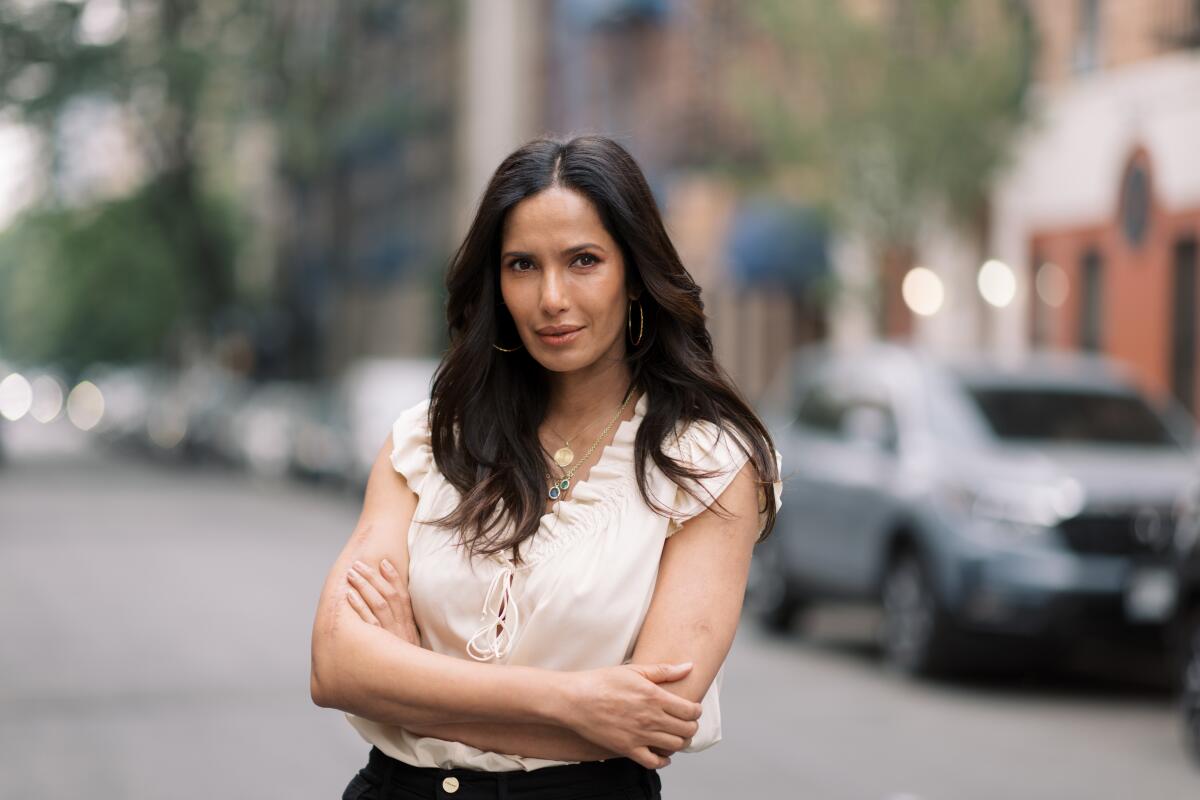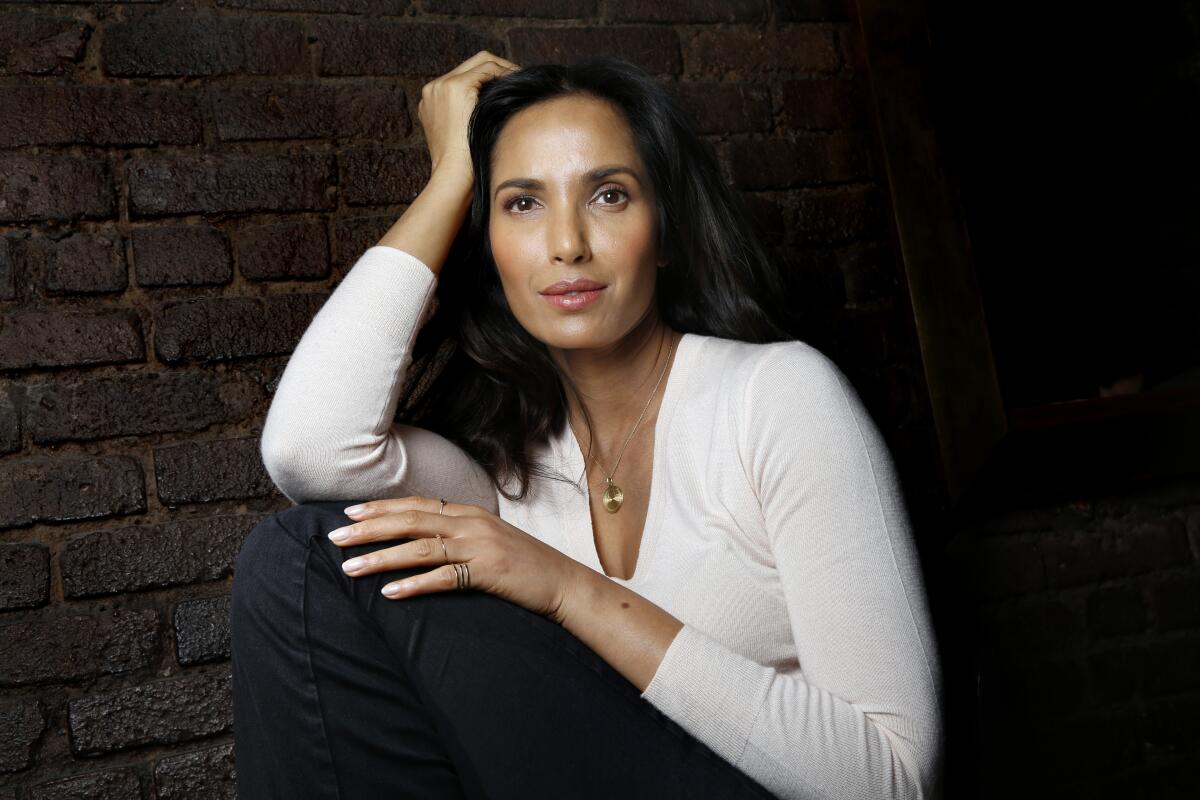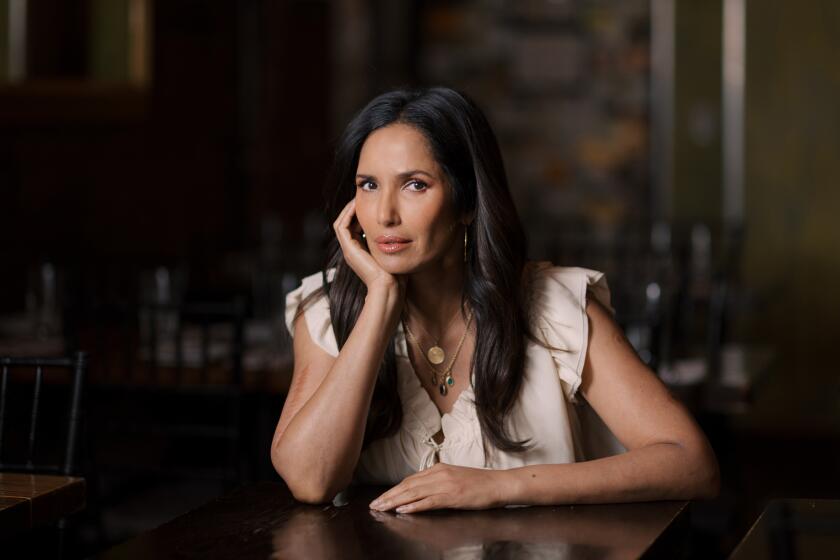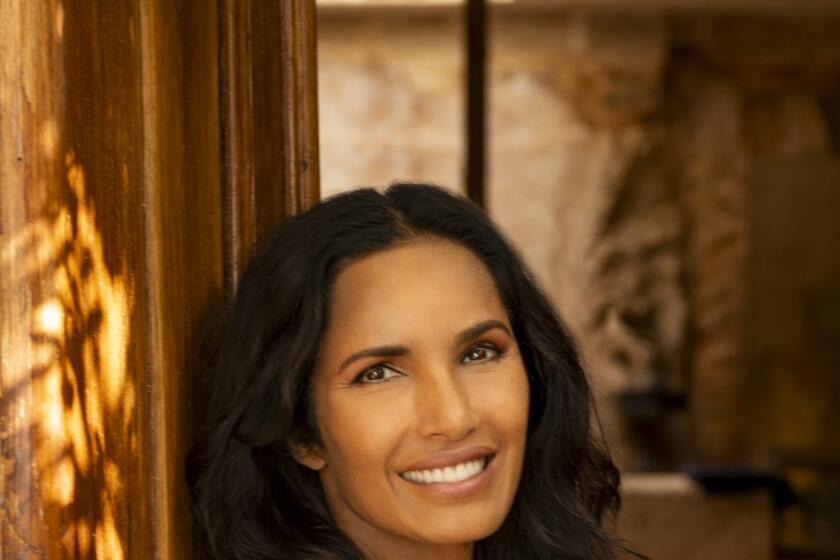Why Padma Lakshmi says ‘Top Chef’ TV cooking helped her home cooking

- Share via
During her time on Bravo’s “Top Chef,” Padma Lakshmi went from fashion model turned high-gloss cooking competition host to a respected authority in the food world with her own James Beard Award. But after 19 seasons and hours in hair and makeup, long waits in dressing rooms and standing on set under hot lights in high-slit dresses and strappy heels, she felt like something was missing.
It wasn’t until her Hulu series, “Taste the Nation with Padma Lakshmi,” which spirited her away from the red carpet and glamour pages and into immigrant enclaves around the country, that she started to find what she was looking for.
“I identify with those people,” says Lakshmi, who moved to the U.S. from Madras, India, when she was 4 and lived in both Queens, N.Y., and Southern California. “I grew up very blue collar in La Puente. My mom’s a retired nurse. My stepdad’s a plumber. I’ve seen how people act one way toward me but another way toward my mom, this little old Indian lady crossing the street.”
Last month, Lakshmi received three Emmy nominations — two for “Top Chef” as host and executive producer and one for “Taste the Nation.” Alongside the recognition, however, comes uncertainty. She recently announced she was stepping away from “Top Chef,” and hasn’t heard word of a renewal for “Taste the Nation.”
“We don’t know, frankly, if we have another season,” says Lakshmi. “As someone who just left her other job, it’s very scary, a very vulnerable place to be. But I have to take a chance on my creative self. And I feel a lot of responsibility to all the people who shared their stories with us.”
The longtime star of Bravo’s cooking competition explains what spurred her sudden exit, who she’d like to host next and the worst dishes of her run.
As overseer of “Top Chef’s” Quickfire Challenge, you spent twice as much time on set as your co-hosts Gail Simmons and Tom Colicchio. Talk about what you learned.
What they do in the Quickfire, to me, is much closer to how people actually cook in real life. Of course, they’ve got the skills of professional chefs, the best ingredients, as well as equipment. But you don’t have much more than 20 minutes to gather your thoughts. And you become really resourceful.
Walk us through the process.
You have a recipe in your head, and you’ve always made it with scallops. But in some Quickfire challenges, we remove certain ingredients you think are going to be there. So there are no scallops to be found. What can you do? Can you make it with shrimp? Will the dish look as beautiful because shrimp has a different shape? It won’t. So how do you adapt almost instantaneously in real time? You adjust. What I’ve learned over the years, when I’m thinking of what to cook or about a new recipe for a cookbook, [is to] do what they do. I’ll take a recipe I know and love and see if I can change it into something else using the same formula.
For example?
I spent most of my 20s in Italy. And I ate a lot of risotto. I love risotto. But it was very difficult for me to deal with al dente rice because I’m a rice snob from the land of Basmati rice. But I always love the concept and comfort of risotto, because it’s very similar to a lot of South Asian dishes I grew up with. I remember making something very quickly out of whatever leftover stuff I had when I was cooking something, and I loved it so much, I froze a portion so I’d remember it. I’ve gone and refined that recipe. I’m going to include it in a new cookbook. It’s a South Asian adaptation of a risotto dish using the same principles of risotto, but with completely different ingredients, except for the rice. It’s creamy but doesn’t use cream. It’s one of my top five favorite recipes.

The project you reference is your upcoming “Taste the Nation” cookbook, right? Was it easy to get people to share family recipes?
No!
What do you do if your request is declined, but you think it’s important to include it?
If I taste a dish once or twice, or I see you make it, it may not be exactly the same, but I can replicate it. That’s why I’m a good cook. I have the nose of a bloodhound. I always have. I’m a super taster. That’s the only extra skill I have. I’ve always hunted recipes down. Even when I was a model, I’d go shoot somewhere exotic and the first thing I’d do is ask cab drivers where I should eat. And I’d go into markets and bring back all these strange twigs and seeds. I love doing that.
The ‘Taste the Nation’ host travels the U.S. to explore different cultural influences and traditions.
What’s your take on originality in a recipe?
Nothing is truly original. Everything comes from something else and was taught to you by someone else. The alchemy of originality is that you distill all the influences we have into something that’s uniquely funneled through your own palate and experience. That, to me, is the most exciting part of cooking. And it’s also to me the most exciting part of “Top Chef.” I prefer the Quickfires to the Elimination Challenge, which I realize takes up most of the show, and someone goes home, so there’s a lot more stakes involved. But there’s something so exciting about seeing a chef use all of their creative juices and just do what they can to gain an advantage in the next challenge.
You’ve said that “Taste,” not “Top Chef,” is what most enriched your cooking. How so?
It’s a much slower process. We take two days to make a 42-minute episode of “Top Chef.” We take a week to make a 30-minute episode of “Taste the Nation.” It’s more in depth and it’s also me with one cook, not a roomful of contestants. For the most part, I’m going to people’s homes, and they’re [not] doing traditional, stereotypical American food. But they’re also not doing traditional Cambodian or Chinese food. They grew up here, [so] they’re doing a third thing, which is the commingling of two cultures and also of making do when you [can’t] find all the ingredients. And that third thing? It’s my happy place.
Does that have roots in your upbringing?
I was raised as a latchkey kid by a single mom who was a nurse and had to come home after being on her feet all day at the hospital, and make something that was nutritious, inexpensive and quick for us to eat. I saw her make a traditional South Indian dish called upma with a box of Cream of Wheat, because she couldn’t hike her butt all the way to Jackson Heights and get the real ragi [finger millet].
Has being around so many skilled chefs changed how you cook?
It’s not readily quantifiable, but I think it’s made me looser and more accepting of my own cooking style. What I felt in my first few years at “Top Chef” was this huge sense of imposter syndrome. I didn’t go to culinary school or work the line under any great chef. I didn’t understand how to use a sous vide machine. After a couple of years, somebody sent me this very highfalutin, beautiful, expensive sous vide machine and I thought, “You know what? I don’t like sous vide meat.” So I gave it away to somebody very excited to receive it.
You’ve written two cookbooks, a memoir and an encyclopedia of spices and herbs, but won your first James Beard Award just last year for “Taste the Nation.” What took so long?
I don’t think I was on their radar. I don’t have a restaurant. I’m not one of those writers who produces a cookbook every year. I’m a slow writer. I can’t imagine churning out 75 or 100 recipes every year. I think they just weren’t thinking about it. Listen, I’m just excited they finally did see fit to recognize my work. I came to the professional food world quite late in life. I published my first cookbook [“Easy Exotic”] when I was 29. The byline was “A Model’s Low-Fat Recipes From Around the World.” Nobody took me seriously or expected [it] to be any good. But people are still cooking out of it.
More to Read
Eat your way across L.A.
Get our weekly Tasting Notes newsletter for reviews, news and more.
You may occasionally receive promotional content from the Los Angeles Times.












